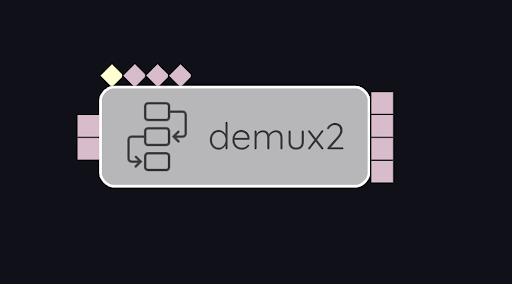demux2

| Name | Type | Description | Optional |
|---|---|---|---|
latency |
int |
amount to fill each output port before first firing |
|
case0 |
?0 |
case selector for out0 |
yes |
case1 |
?0 |
case selector for out1 |
yes |
… |
|||
caseN-1 |
?0 |
case selector for outN-1 |
yes |
| Name | Type | Description | Optional |
|---|---|---|---|
selector |
?0 |
selector value |
no |
input |
?1 |
data to be routed to selected output no |
| Name | Type | Description | Optional |
|---|---|---|---|
selector |
?0 |
selector value (echoed to output) |
|
out0 |
?1 |
output selected when case0 is matched |
yes |
out1 |
?1 |
output selected when case1 is matched |
yes |
… |
|||
out N-1 |
?1 |
output selected when case N-1 is matched |
yes |
demux2 is intended for use in realtime DSP applications and isn’t intended for cloud applications. It is the same as switch, except that it has an additional parameter port called latency, and an additional output port called selector. Before the first firing of the demux2 node, latency default values of type ?1are sent to every connected output port, and latency In other words, if the latency (value of the latency parameter) is 7, then 7 default values – values equal to <?1>() in Transparency) are sent to every connected output port. A mux2 is used to close the demux2. The result is that the selector value can be switched at the sample rate in real time without breaking the flow of signals in the conditional structure. It is important to note that the selector input runs latency sample periods behind the data inputs and outputs. This makes this node utterly unsuitable for use other than in certain realtime DSP scenarios.
Not recommended for use in AWS applications.